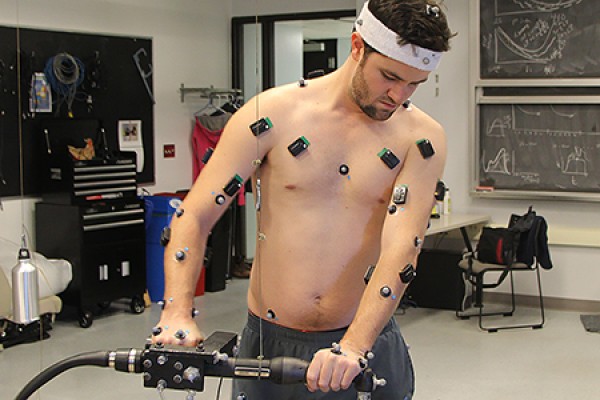 Master’s student Paul Leuty recreates motions for capture by a computer-generated mannequin.
Master’s student Paul Leuty recreates motions for capture by a computer-generated mannequin.
A University of Windsor researcher is working to help injured workers return to the job more quickly and safely.
Joel Cort, an associate professor of kinesiology, uses computer software to simulate the precise movements a human body performs when working on an automotive plant’s assembly line. He is digitally recreating automotive assembly stations in an effort to improve return-to-work protocols for those who may have experienced a work-related injury.
“We are using advanced ergonomics tools to watch computer mannequins literally go through the exact motions a worker would go through, to help understand where and how injury occurred,” says Dr. Cort.
The software resembles a video game where the user, or researcher, gives commands and the digital mannequin responds. Predictive motion algorithms are calculated to demonstrate what is physically required to carry out a task, including how the muscles move during a task and taking into consideration how much a tool weighs, or how much force is required to install a part.
“This technology gives me the opportunity to acts like a movie director, like the Martin Scorsese of ergonomic research,” says Cort. “I direct the mannequin, the way you’d direct an actor, with special interest in estimating how safe it is for a person to pose, grasp, bend, sit, stand or apply force.”
His lab created a digital library of human movement by hooking people up to monitors and having them act out the exact movements required to work at a particular assembly plant workstation. They logged the movements, including how much force is required and how a body bends.
“Ultimately we want to use proactive ergonomics and design better workstations before they are physically built,” says Cort. “However, in the event of a work-related musculoskeletal injury, we can provide information from ergonomics software to healthcare professionals, to aid in both the design of rehabilitation programs and return-to-work decisions.”
The goal of the simulation program is to create a video that explains exactly what a worker’s body was doing on the job, so doctors and physical therapists can help tailor return-to-work programs.
The video also helps identify how a worker’s physical capacity has changed after an injury. When doctors fill out return-to-work protocols for rehabilitated workers, they will be able to assess more accurately which workstations may be off-limits, and help ensure workers are placed in jobs that do not put them at risk of re-injury.
“It’s in the best interest of everyone: the company, the insurance provider and the union, to keep workers safe and healthy,” says Cort. “Research proves that good ergonomics keeps people healthy, increases the quality of job, boosts moral and reduces costs associated with injuries.”
The project is a collaboration between Cort, the insurance provider Great West Life, Ford Motor Company’s assembly plant in Oakville, and MITACS, a not-for-profit organization that designs and delivers research and training programs in Canada. The simulation software is designed by Siemens.
